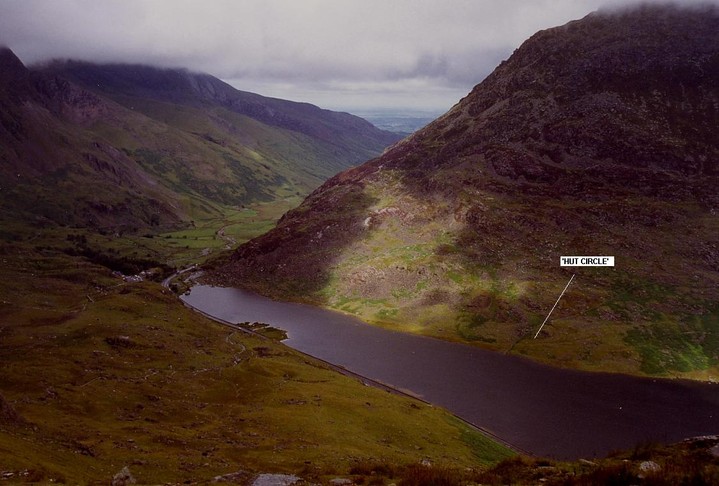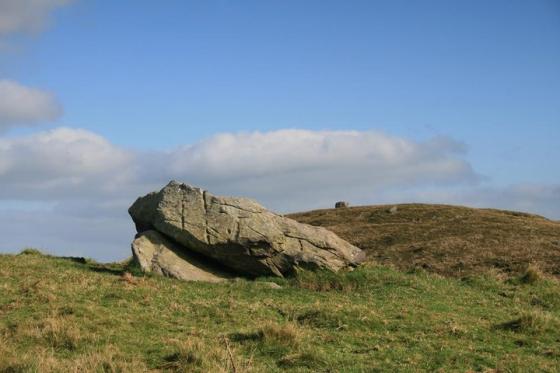
The settlement is far right, above the lakeshore. Tryfan and Y Garn preside.

The settlement is far right, above the lakeshore. Tryfan and Y Garn preside.

Location, location, location. I’m sold.

Looking southwest towards Cwm Idwal and Y Garn.

Looking across the site and Llyn Ogwen towards Tryfan.

If it is prehistoric, it’s well preserved.

Pen yr Ole Wen towers above.

Arriving at the “house” on the footpath from the southwest, which cuts straight through the middle of it.

Seen from Twll Du, across Cwm Idwal. The summit cairns on Carnedd Dafydd are hidden behind the daunting rock buttresses of Pen yr Ole Wen.

Further landscape context from Glyder Fach.

The settlement nestles in the steep-sided Ogwen Valley, between the formidable rock faces of Tryfan and the Glyderau to the south and Pen yr Ole Wen to the north.

Dragon’s shadow passing over the settlement site.

Further landscape context and a fair-weather companion to Gladman’s image. The Ogwen Valley curves away NW towards Ynys Mon, with the western Glyderau (Y Garn, Elidir Fawr, Foel Goch, Mynydd Perfedd and Carnedd y Filiast) flanking the valley’s side.

The rocky flank of Pen yr Ole Wen towers above the site, the approx position of which is indicated.

Dawn, Llyn Ogwen.... not a bad place to live. The mighty foot of Tryfan dominates, top right.

Looking from Tryfan.... the location of the site is approximately indicated upon the northern shore of Llyn Ogwen. Pen yr Oleu Wen towers above, Nant Ffrancon the valley beyond.
The failure of the wrong person to secure [treasure] is illustrated by a story given by Mr. Derfel Hughes in his Antiquities of Llangedai and Llanllechid, pp. 35-6, to the effect that a servant man, somewhere up among the mountains near Ogwen Lake, chanced to come across the mouth of a cave with abundance of vessels of brass (pres) of every shape and description within it.
He went at once and seized one of them, but, alas! it was too heavy for him to stir it. So he resolved to go away and return early on the morrow with a friend to help him; but before going he closed the mouth of the cave with stones and sods so as to leave it safe. While thus engaged he remembered having heard how others had like him found caves and failed to refind them. He could procure nothing readily that would satisfy him as a mark, so it occurred to him to dot his path with the chippings of his stick, which he whittled all the way as he went back until he came to a familiar track: the chips were to guide him back to the cave.
So when the morning came he and his friend set out, but when they reached the point where the chips should begin, not one was to be seen: the Tylwyth Teg had picked up every one of them. So that discovery of articles of brass – more probably bronze – was in vain.
But, says the writer, it is not fated to be always in vain, for there is a tradition in the valley that it is a Gwydel, ‘Goidel, Irishman,’ who is to have these treasures, and that it will happen in this wise:--
A Gwydel will come to the neighbourhood to be a shepherd, and one day when he goes up the mountain to see to the sheep, just when it pleases the fates a black sheep with a speckled head will run before him and make straight for the cave: the sheep will go in, with the Gwydel in pursuit trying to catch him. When the Gwydel enters he sees the treasures, looks at them with surprise, and takes possession of them; and thus, in some generation to come, the Gwydyl will have their own restored to them.
Ancient bronze objects in Celtic Folklore, Welsh and Manx by John Rhys (1901).
Here’s an obscure one... although if it had have been sited on the southern shore of Llyn Ogwen, it probably wouldn’t have been. Yeah, set upon the northern shore of the beautiful lake, Pen yr Oleu Wen towering immediately above, the incomparable Tryfan rising across the water, there can surely have been few more intoxicating places to live, assuming the occupants were ‘in tune’ with the landscape. Few more brutal, too, particularly when the winter storms rage. And somewhat at risk from rock falls, one would have thought? Although not marked on the OS map, the Gwynedd Archaeological Trust people have neverthless paid a visit – as you would expect – and reckon it is most probably the real deal. To quote from their notes (PRN 5008):
‘Massive walls and a neatly levelled interior suggest that the rectangular structure discovered N of Llyn Ogwen originally functioned as a habitation site. The surviving masonry is about 1m wide and 1.5m high and the walls incorporate large boulder. Externally the site measures 5m by 8.5m. The most striking aspect of this structure is that it is bisected by what appears to be the continuation of the packhorse trail described at the W end of Llyn Ogwen. Stones from the walls have been used to mark the edge of the track as it passes through the house and for 8m on either side. Gaps 2 to 2.5m wide have been cut in the walls of the house so the original entrance has been obscured and there is no evidence of any other internal features’. [Sources: Smith, G. , 1998 , Hut Circle Settlement Survey; Latham, J. & Plunkett Dillon, E. , 1986 , Archaeology in Wales].
So there you are. A public footpath follows the north bank of the llyn, accessible from both ends. Worth a wander, perhaps?

















































































































































































































